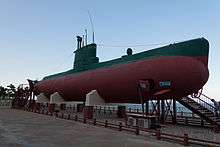1996 Gangneung submarine infiltration incident
| Infiltration of Gangneung | |||||||
|---|---|---|---|---|---|---|---|
 The Sang-O-class submarine stranded on the South Korean coast | |||||||
| |||||||
| Belligerents | |||||||
|
|
| ||||||
| Strength | |||||||
| 43,000 personnel |
1 Sang-O-class submarine 26 personnel | ||||||
| Casualties and losses | |||||||
|
12 killed
|
24 killed
1 missing 1 submarine captured[1] | ||||||
| 4 South Korean civilians killed[2] | |||||||
The 1996 Gangneung submarine infiltration incident occurred on September 18, 1996, near the South Korean town of Gangneung. The incident was one of the more serious instances of North Korean espionage involving naval forces.
History
Landing
On September 15, a North Korean Sang-O-class submarine landed a three-person special operations reconnaissance team on the east coast of South Korea near Jeongdongjin, 20 kilometres south-east of Gangneung, Gangwon-do. Their mission was to spy on the naval installations in the area and then return. The submarine made a failed attempt to collect the team on the 17th, and returned the following day. The submarine, however, ran aground in the attempt, and all efforts to try to make her free were in vain.
The crew then decided to destroy the sensitive equipment in the submarine and try to make it to the DMZ. The crew split up in several groups but one was soon spotted by a civilian who became suspicious and alerted the authorities, who quickly mobilized.
South Korean manhunt
A 49-day-long manhunt ensued, from 18 September through 5 November, resulting in the capture or elimination of all the crew and members of the reconnaissance team, except one, who is believed to have made it back to North Korea. Four civilians and 12 ROK soldiers (eight by firefight and four accidental) died; 27 soldiers were wounded.
Of the 25 North Korean infiltrators, one was captured, 11 were killed by the other members for failure in responsibility of running aground of the submarine, and 13 were killed in firefights with the ROK Army. Some analysts suspected that the motivation behind the assassination of Choe Deok-geun, South Korean consul for the Russian Far East, was retaliation for these killings.[3][4][5]
The submarine was salvaged and towed to a naval base for investigation. One captured crewmember, the submarine's helmsman, Lee Kwang Soo, gave in after much interrogation and revealed much of the plans. He later became an instructor in the South Korean navy.
North Korea was at first reluctant to take responsibility, claiming that the submarine had suffered an engine failure and had drifted aground. By 29 December, however, the North issued an official statement expressing "deep regret" over the submarine incident, although it did not issue a direct apology. In return, the South Korean government returned the cremated remains of the infiltrators to the North via Panmunjom on 30 December.
Timeline of North Korean casualties
- September 18 16:40 – 1 captured by local police
- September 18 17:00 – 11 bodies of executed submarine crew members were found
- September 19 10:00 – 3 killed by ROKA Commandos
- September 19 14:00 – 3 killed by ROKA SWCs
- September 19 16:00 – 1 killed by ROKA
- September 21 20:00 – 1 killed by ROKA
- September 22 06:00 – 1 killed by ROKA
- September 28 06:30 – 1 killed by ROKA
- September 30 16:00 – 1 killed by ROKA SWCs
- November 5 10:00 – 2 killed by ROKA SWCs
Aftermath

The Sang-O class submarine is on display at Tongil (Unification) Park near Gangneung.
See also
References
- ↑ "North Korea apologizes for submarine intrusion". CNN. 29 December 1996. Retrieved 8 December 2012.
- ↑ "North Korea apologizes for submarine intrusion". CNN. 29 December 1996. Retrieved 8 December 2012.
- ↑ "North Korea denies murdering diplomat", CNN, 1996-10-04, retrieved 2007-06-01
- ↑ Jeong, Hoe-sang (1996-10-17), "최덕근 영사, 러시아 마피아가 살해했다?/Consul Choe Deok-geun, killed by the Russian Mafia?", Sisa Journal, retrieved 2007-06-01
- ↑ Bertil, Lintner (2002), Blood Brothers: Crime, Business, and Politics in Asia, Allen and Unwin, pp. 213–214, ISBN 1-86508-419-0
Bibliography
- Harry P. Dies, Jr.: North Korean Special Operations Forces: 1996 Kangnung submarine infiltration, Military Intelligence Professional Bulletin, Oct-Dec 2004.
External links
Coordinates: 37°43′07″N 129°00′16″E / 37.718680°N 129.004508°E